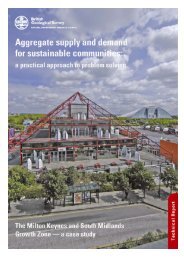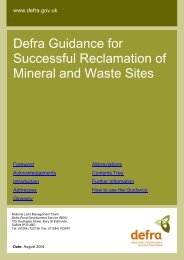creating environmental improvements through biodiversity
creating environmental improvements through biodiversity
creating environmental improvements through biodiversity
You also want an ePaper? Increase the reach of your titles
YUMPU automatically turns print PDFs into web optimized ePapers that Google loves.
3 BIODIVERSITY & MINERAL<br />
SITES<br />
3.1 PLANNING FOR THE LOCATION OF SITES AT BOTH STRATEGIC AND<br />
SITE-SPECIFIC LEVELS<br />
Minimise damage<br />
Mineral sites can have substantial benefits for <strong>biodiversity</strong>. However, setting these potential gains against the<br />
vast historical loss of semi-natural habitats shows that there is no room for complacency when locating new<br />
sites: damage to existing <strong>biodiversity</strong> should always be avoided. Many of the reports reviewed recommend<br />
that the location of future extraction sites should be chosen so that damage to <strong>biodiversity</strong> and other<br />
<strong>environmental</strong> assets are minimised (e.g. Worcestershire County Council, Ryland et al., 2005). Damage to<br />
specific features such as wildlife habitat corridors should be avoided (Stonex & Beeden 2005). It is also<br />
important that less immediately obvious wildlife, such as invertebrates, plants and fungi, are considered at an<br />
early stage in the planning process and negative impact avoided (Roberts and Buffin 2005). Roberts and Buffin<br />
(2005) state that restoration practices promoted by the planning process are not currently benefiting and are<br />
often proving detrimental to invertebrate <strong>biodiversity</strong>.<br />
Sustainable Aggregates Creating Environmental Improvements <strong>through</strong> Biodiversity<br />
James et al. (2004) highlights the predictive Strategic Environmental Assessment (SEA) techniques that could<br />
be used at the level of Minerals Local Plans (or Minerals Development Frameworks) to limit negative impacts<br />
on <strong>biodiversity</strong>. Strategic Environmental Assessments should address potential damage to internationally<br />
and nationally designated sites, and effects on regional Biodiversity Action Plan (BAP) targets for habitats<br />
and species. The report contains useful background and information such as a description of Environmental<br />
Constraints Mapping, where nature conservation designations, landscape designations and ‘BAP areas’ are<br />
mapped against minerals resources. This is used to test whether sites in a development plan are allocated in<br />
the least sensitive locations possible. The British Geological Society (BGS) have produced an online tool that<br />
allows users to carry out this type of constraints mapping (Steadman et al., 2005). Initially covering only the<br />
East Midlands region, this was to be expanded to most of England, and could be a valuable tool for planners<br />
and industry producing Strategic Environmental Assessments and / or Environmental Appraisal of strategic<br />
plans.<br />
Maximise benefits for wildlife<br />
Sites should be located such that opportunities to enhance <strong>biodiversity</strong> are maximised. This may include<br />
ensuring habitat end-uses are agreed when extraction takes place close to existing habitat, in order to<br />
buffer and link remaining patches (Davies, 2006); or planning for larger sites or multiple sites together, in<br />
order to encourage a landscape-scale approach to restoration. However, while bigger sites may be better<br />
for producing valuable restorations, public opinion and multiple ownership may cause problems in approving<br />
large extraction sites (Hafren Water, 2007). When considering landscape scale projects, it is essential to<br />
consider the local area’s character and landscape designations (Allen, 2004, Worcestershire County Council).<br />
It would be valuable for the heritage sector to provide historic data on the area, where this exists, and engage<br />
13

















